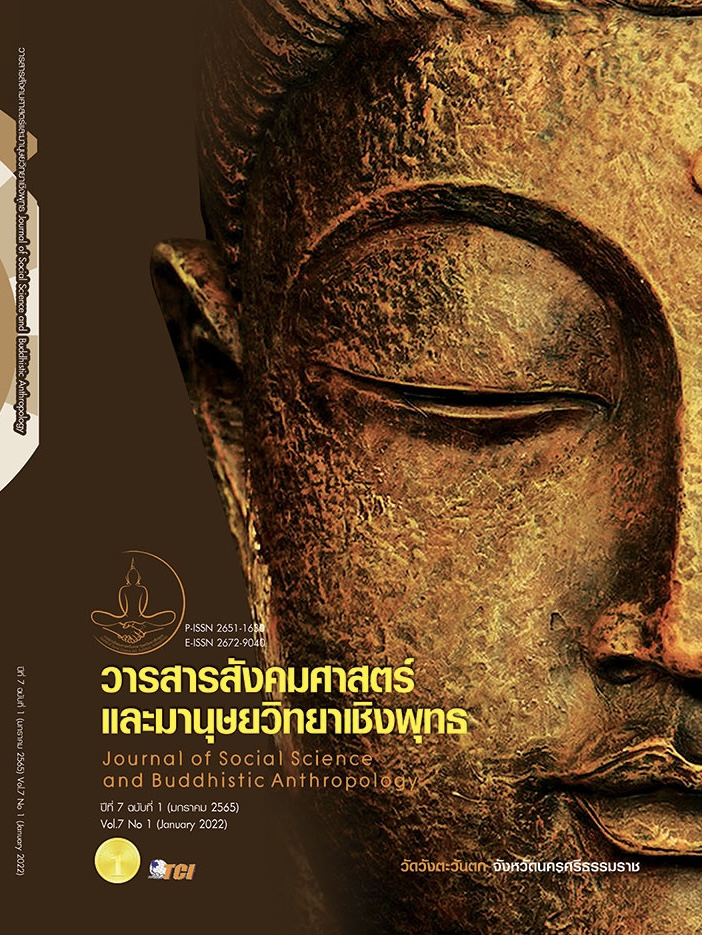STUDY OF THE UTILIZATION OF DANCE THERAPY TO LESSEN DEPRESSION AMONG FRIST - YEAR STUDENTS AT RISK OF DEPRESSIVE DISORDER IN THE FACULTY OF FINE ARTS AT SRINAKHARINWIROT UNIVERSITY
Keywords:
Movement therapy, Depression, First-year students, Faculty of Fine ArtsAbstract
The objectives of this research article were to study the use of movement therapy to lessen depression who are at risk of developing depressive disorder. The study focuses on the creation of movement therapy to decrease the risk of developing depressive disorder. The study also aims to study the results before and after the application of therapy to reduce depressive disorder among the first-year students in the Faculty of Fine Arts at Srinakharinwirot University. The sample group consisted of 24 first-year students in the Faculty of Fine Arts at Srinakharinwirot University who were at risk of developing depressive disorder. The sample group was divided into two categories: the experimental and control groups, each consisting of 12 samples. The research on the experimental group compared the outcomes before and after the experiment. The researcher collected the data and conducted experiments using a t-test, statistical mean and standard deviation. The findings were as follows: 1) the creation of a dance therapy plan to reduce depression among the samples, who were at risk of developing depressive disorder, yielded 12 activities that focused on physical movement and perception, movements with feelings and emotions and the process of thought and behavioral adjustment linked to ideas, behavior, emotions, and the body. The activities were performed once a week for 60 minute per week for 12 weeks. According to the consideration of index of item objective congruence (IOC) by qualified experts, they concurred with high satisfaction on the approach and the appropriateness of dance therapy; and 2) the results before and after the use of movement therapy to lessen depression among the first-year students revealed that the mean of experimental group before therapy was 29.17, with a standard deviation value of 5.557, and the mean of experimental group before the therapy was 20.67 with a standard deviation value of 1.557. It was found that the mean derived after the use of dance therapy was significantly lower than before the therapy by .05.
References
จักรพงษ์ แพทย์หลักฟ้า. (2554). กิจกรรมศิลปกรรมบำบัดเพื่อฟื้นฟู เยียวยา ผู้ประสบอุทกภัย. วารสารสถาบันวัฒนธรรมและศิลปะ, 13 (1), 24-26.
ปาหนัน กฤษณรมย์. (2563). ผลของกิจกรรมดนตรีบำบัดต่อความสามารถในการรับรู้และตอบสนองต่อดนตรี พัฒนาการ และคุณภาพชีวิตของเด็กออทิสติก. วารสารปาริชาติ, 33(2), 168-181.
พิณธร ปรัชญานุสรณ์. (2548). ผลของนาฏกรรมบำบัดต่อคุณภาพการนอนหลับของผู้สูงอายุในชมรมผู้สูงอายุ. ใน วิทยานิพนธ์วิทยาศาสตรมหาบัณฑิต สาขาวิทยาศาสตร์สุขภาพจิต. จุฬาลงกรณ์มหาวิทยาลัย.
ศรียา นิยมธรรม. (2545). สารานุกรมศึกษาศาสตร์. กรุงเทพมหานคร: คณะศึกษาศาสตร์ มหาวิทยาลัยศรีนครินทรวิโรฒ.
สุนันท์ เสียงเสนาะ. (2560). อิทธิพลของปัจจัยด้านสัมพันธภาพระหว่างบุคคลต่อภาวะซึมเศร้าของวัยรุ่นตอนปลาย. ใน วิทยานิพนธ์ปริญญามหาบัณฑิต สาขาวิชาการพยาบาลสุขภาพจิตและจิตเวช. มหาวิทยาลัยบูรพา.
อรพรรณ ลือบุญธวัชชัย และพีรพนธ์ ลือบุญธวัชชัย. (2553). การบำบัดรักษาทางจิตสังคมสำหรับโรคซึมเศร้า. กรุงเทพมหานคร: สำนักพิมพ์แห่งจุฬาลงกรณ์มหาวิทยาลัย.
อิงอร แก้วหวาน. (2550). ปัจจัยที่มีอิทธิพลต่อภาวะซึมเศร้าของวัยรุ่น อำเภอสัตหีบ จังหวัดชลบุรี. ใน วิทยานิพนธ์พยาบาลศาสตรมหาบัณฑิต สาขาสาขาวิชาการพยาบาลสุขภาพจิตและจิตเวช. มหาวิทยาลัยบูรพา.
AM01. (8 ธันวาคม 2563). ความรู้สึกที่เกิดขึ้นในขณะทำกิจกรรม. (นางสาวนุชนารถ รอดสอาด, ผู้สัมภาษณ์)
AM01. (1 ธันวาคม 2563). ความรู้สึกที่เกิดขึ้นในขณะทำกิจกรรม. (นางสาวนุชนารถ รอดสอาด, ผู้สัมภาษณ์)
AW02. (8 ธันวาคม 2563). ความรู้สึกที่เกิดขึ้นในขณะทำกิจกรรม. (นางสาวนุชนารถ รอดสอาด, ผู้สัมภาษณ์)
AW06. (8 ธันวาคม 2563). ความรู้สึกที่เกิดขึ้นในขณะทำกิจกรรม. (นางสาวนุชนารถ รอดสอาด, ผู้สัมภาษณ์)
Jillian R. Ranker. (2016). Is Dance/Movement Therapy an Effective Treatment for Depressionin Students? In The Degree of Master of Science In Health Sciences – Physician Assistant. Philadelphia College of Osteopathic Medicine.
Koch, S. C. et al. (2007). The joy dance Specific effects of a single dance intervention on psychiatric patients with depression. The Arts in Psychotherapy, 34(2007), 340–349.
Mala, A. et al. (2012). Dance/Movement Therapy (D/MT)for depression: A scoping review. The Arts in Psychotherapy, 39(4), 287-295.
Tanenbaum, S. J. et al. (1996). Mindfulness in movement: An exploratory study of body-based intuitive knowing. Newton, Massachusetts: Massachusetts School of Profressional Psychology.
Downloads
Published
How to Cite
Issue
Section
License
Copyright (c) 2022 Journal of Social Science and Buddhistic Anthropology

This work is licensed under a Creative Commons Attribution-NonCommercial-NoDerivatives 4.0 International License.








